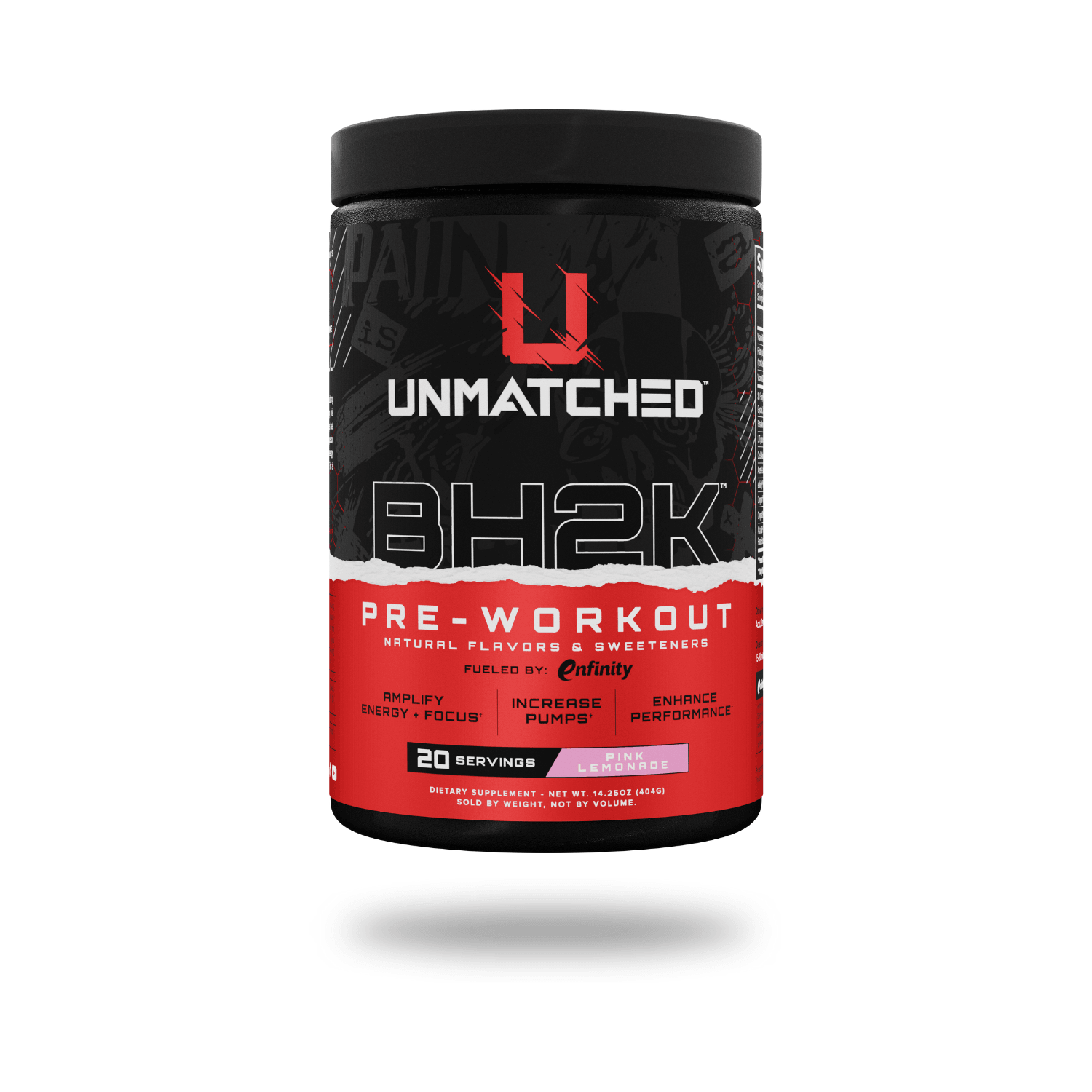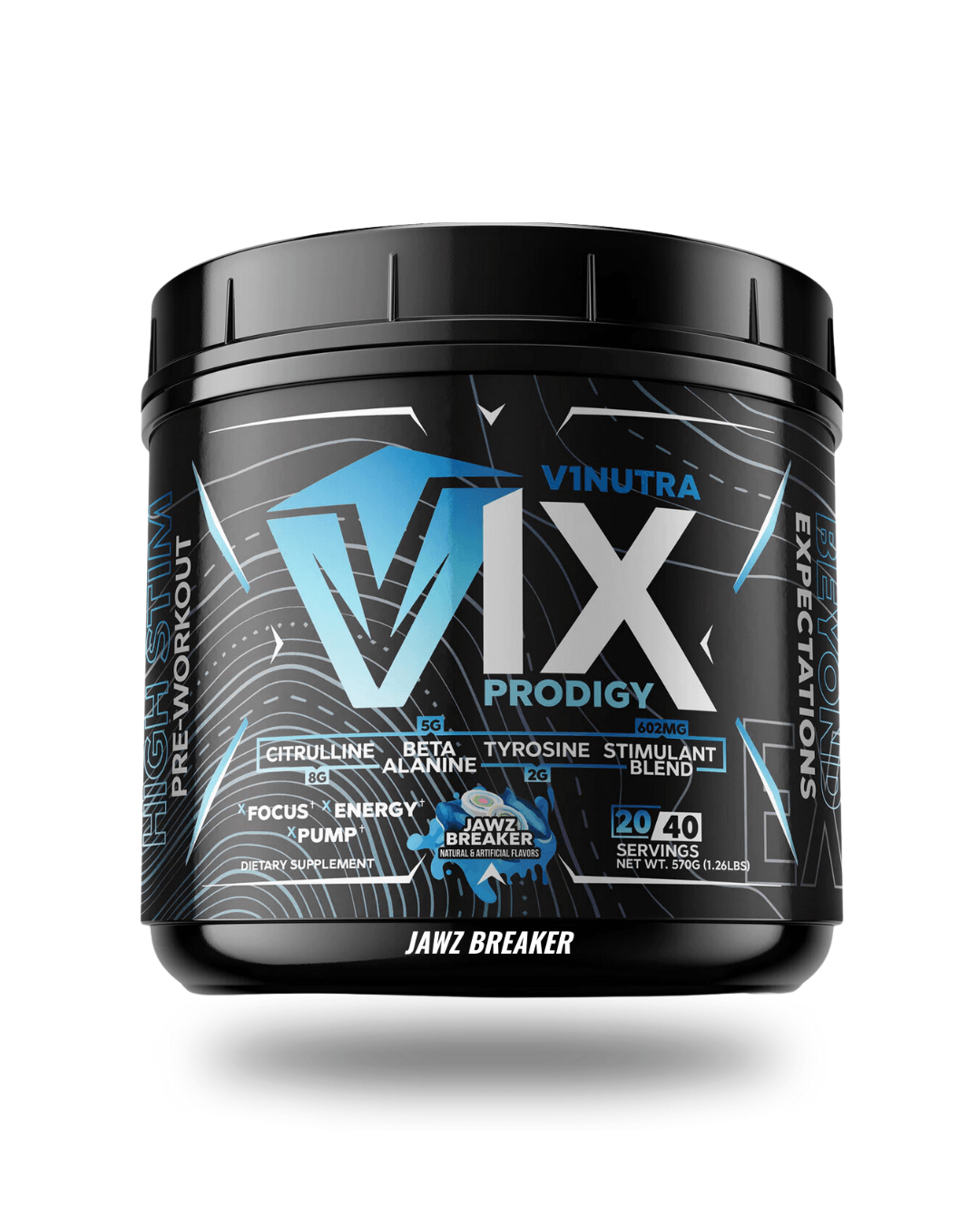Description
BH2K™ is a pre-workout that bridges the gap between optimal bodybuilding performance and health-span. Providing superior pumps, heightened mental focus, and euphoric energy.
Not all pre-workout supplements are created equal. Introducing our new groundbreaking pre-workout formulation, BH2K®, a true paradigm shift in the world of fitness supplements. Carefully formulated with a relentless commitment to excellence, our innovative blend includes never before seen combinations of ingredients backed by the power of cutting-edge science. 100% naturally sweetened, flavored, and colored, each serving delivers a potent fusion of performance-boosting ingredients, including the revolutionary 3DPump Breakthrough®, energizing Enfinity® Paraxanthine, focus-boosting Cognizin® citicoline, and the muscle-supporting CreGAAtine®, among others. Prepare to transcend your limits and redefine your workout experience. With our next-level pre-workout solution you’ll undoubtedly Be Harder 2 Kill.
3DPUMP Breakthrough® [L-Citrulline (Vegan Fermented) (3000mg), Glycerol, Amla (Phyllanthus emblica) Fruit Extract]
3DPUMP Breakthrough® is a revolutionary new ingredient that is a patented combination of Fermented L-Citrulline, Glycerol (high yield), and a standardized extract of Amla Fruit. This ingredient supports increase vasodilation to the target muscle as well as improved endurance during training by utilizing complimentary pathways of action. If we break down each of these ingredients individually, we can begin to understand what makes this unique combination so beneficial.
- L-Citrulline - amino acid that converts to arginine and supports nitric oxide production, which aids blood flow and increase muscle pumps. Citrulline has also been shown to enhance exercise performance (particularly in resistance training protocols), boost power, reduce the onset of fatigue, and aid recovery.
- Glycerol - another common inclusion in pre workout supplements that serves as an osmolyte, which means it encourages muscle cells to attract and absorb more water. This increases cell volumization and cellular swelling, which not only enhances the pump but gives a full look to your muscles.
- Amla - has a long history of use in Indian medicine as a cardiotonic. It’s high in polyphenols and flavonoids (including pedunculagin, puniglucanin, emblicanin A, and emblicanin B) that are known to possess antioxidant activity and support cardiovascular health.
It’s common to find L-Citrulline and Glycerol amongst other nitric oxide and pump inducing ingredients with a track record of efficacy but the real question is if the addition of Amla enhances the experience. Studies have shown that this answer is undoubtedly yes! One study measured cell volumization and muscle swelling because of performing lower body exercises using multiple interventions, which included placebo, 1500mg glycerol, 150mg Amla, and 1350mg glycerol + 150mg Amla. The results showed that all interventions, including placebo, produced positive results on leg size and lean body mass, however, the glycerol + Amla produced significantly better results than the other interventions. The glycerol + Amla group increased their thigh circumference by 2.21 cm on average and had an increase of 693.1 grams in total body mass. These results make the combination of adding Amla to the already classic benefits of L-Citrulline and Glycerol extremely promising when it comes to making positive improves in your goals when it comes to sport performance products.
Beta Alanine
Carnosine is a bit of an odd duck: we know that it is crucial for muscle function, and that dietary sources of carnosine are essential, but we don’t know precisely how it’s working. Moreover, for decades, we had no idea how to increase intramuscular concentrations, as exogenous carnosine sources degraded in the body so fast as to be effectively useless.
Enter beta-alanine. Simply a different iteration of one of the amino acids that comprises carnosine itself (alanine), beta-alanine has proven to be the most effective means of significantly increasing intramuscular concentrations of carnosine – and therefore of promoting all of carnosine’s various beneficial effects on muscle performance. If that weren’t enough, beta-alanine has also demonstrated beneficial physiological effects independent of its parent compound. To understand why, though, we need to first understand some of the basics behind carnosine itself.
Carnosine, a cytoplasmic dipeptide synthesized from the precursors L-histidine and l-alanine, is present in high concentrations in skeletal muscle and plays a pivotal role as a, “chemical buffer” in myocytes (muscle cells). It has long been known that carnosine concentrations are highest in glycolytic, rather than oxidative muscle fibers (roughly speaking, explosive vs endurance muscle fibers, respectively), and thus long hypothesized that this amino acid is required for sustained performance during supramaximal exercise. Recent research demonstrates that carnosine exerts its physiological effects in long hypoxic (low oxygen) drives by functioning as a high-capacity pH buffer in skeletal muscle, preventing the pH ratio of plasma from dropping too low – and therefore preventing crucial pH-dependent processes such as protein synthesis from being inhibited by acidosis.
Despite its critical role in skeletal muscle anaerobic performance, intramyocellular synthesis of carnosine is rate-limited by the availability of l-alanine. Unfortunately, the majority of literature demonstrates that attempting to increase intramuscular levels of carnosine via either direct carnosine or alanine supplementation is largely ineffective due to carnosine/alanine pharmacokinetics. Enter beta-alanine. Research with beta-alanine demonstrates consistent and dose-dependent increases to intramuscular carnosine concentrations with beta-alanine supplementation, with certain studies showing an increase of 40-60% with chronic administration. These same literatures reveal a synergistic effect of exercise on beta-alanine supplementation, whereby the muscle adaptive changes associated with resistance training promote further intramuscular carnosine production in response to beta-alanine supplementation.
In simpler language, this essentially means that beta-alanine is a dietary supplement that promotes its own effects in combination with exercise. As you exercise, you simultaneously intensify beta-alanine’s physiological actions – both directly, as well as in the production of intramuscular carnosine. Once ingested, beta-alanine’s exercise-specific beneficial activity is well-established. Elevation of intramuscular carnosine content via beta-alanine supplementation has been shown to improve performance in the following ways.
- Both acute and chronic increases in total work capacity, measured by total volume during exercise sessions.
- Highly significant increases to TTE (total time to exhaustion), one of the most accurate and comprehensive measures of endurance. In various trials, beta-alanine supplementation has been shown to increase TTE by upwards of 20%.
Increases to total muscle power output in both acute and chronic trials, suggesting that beta-alanine’s most significant benefit is to those engaging in power-dependent resistance training.
In total, a significant body of research exists to suggest that beta-alanine may significantly increase muscle power output, strength, training volume and output, overall performance in hypoxic (oxygen-deprived) conditions and peak VO2 max (oxygen holding capacity).
These myriad benefits make beta-alanine both one of the most-studied, and most well-rounded dietary supplements. Beta-alanine not only has direct, actionable physiological effects, but also promotes critical muscle physiologic adaptations that promote its own effects.
L-Tyrosine
Tyrosine is amongst a class of amino acids known as ‘non-essential’ amino acids, so called because the body can produce them endogenously, and it is therefore not essential to consume dietary tyrosine. That said, tyrosine is also what is known as a conditionally-essential amino acid; conditionally-essential because, along with glucose and ammonia, the synthesis of tyrosine additionally requires adequate levels of phenylalanine. Once synthesized, tyrosine is one of the most critical amino acids, given its prominent role as a substrate in the synthesis of the catecholamines dopamine, norepinephrine, and epinephrine, in addition to both T3 (triiodothyronine) and T4 (thyroxine) thyroid hormones.
In studies on stress modulation, tyrosine has been demonstrated to reverse stress-induced norepinephrine depletion and the depressant-behavioral effects normally associated with it. In simpler terms, tyrosine may, in certain conditions, dampen the extent to which norepinephrine is removed from the bloodstream during a stress event. In simpler terms still, tyrosine may help to mitigate the sense of depletion and fatigue felt at the end of a workout.
Tyrosine may also play important metabolic functions, mostly related to its role in synthesizing compounds which stimulate the nervous system. While not traditionally considered a sympathomimetic amine, studies which have coadministered tyrosine and stimulants demonstrate a synergistic effect. These studies suggest that tyrosine may potentiate the effects of both endogenous and supplemental norepinephrine and its mimetics (in the case of exogenous use) with respect to lipolysis, thermogenesis, and energy expenditure. Meaning that tyrosine may play a role in assisting norepinephrine to break up triglycerides and increase body heat transiently.
CreGAAtine®
CreGAAtine® is a new and innovative ingredient combining creatine monohydrate and guanidinoacetic acid (GAA). We can break this ingredient down into two separate parts and summarize how the combination of these two compounds works together to produce desired results.
Creatine Monohydrate
Sometimes called the “grandfather” of dietary supplements, creatine is, along with caffeine, one of the most extensively studied dietary compounds. Certainly, it is the most well-studied ergogenic aid. The extensive amount of data on creatine demonstrates that it positively contributes to dilation of the vasculature, plasma-nutrient mobilization, post-workout nitrogen retention and protein synthesis, along with dose-dependently increasing contractile force through ATP (adenosine triphosphate) provision (i.e., it helps support increased strength).
If the human body could be considered a bank account, then ATP would be the currency, and every cellular process would be like spending a little money from that account. Without making a deposit, the account runs dry (fatigue). Unfortunately, making a direct deposit to that account in the form of exogenous adenosine triphosphate is impossible, given that ATP itself is incredibly unstable. The use of supplemental creatine, however, is analogous to making a deposit in the body’s energy bank, given that creatine is eventually metabolized to ATP via several steps. In skeletal muscle, creatine is first phosphorylated into its primary derivative, known as phosphocreatine (PCr), by the muscle-specific creatine kinase, creatine kinase-MB (muscle-brain). Following the phosphorylation of creatine, phosphocreatine may then anaerobically donate a phosphate molecule to adenosine diphosphate (ADP) to form the ATP required during the initial stages of intense muscular contraction. The result is not only an increase in contractile force, but also an increase in potential type IIx (‘fast-twitch’) muscle recruitment – the type of muscle fibers which are not only traditionally associated with speed, strength, and impressive physiques, but which are also unsurprisingly the most energy-demanding fiber types. Literally speaking, creatine contributes to the building of muscle.
Both through the ATP provision just described, as well as effects on nutrient mobilization, protein-sparing, and fluid dynamics, creatine has been consistently demonstrated to increase both lean mass and muscle mass in clinical data. In the short-term, these effects are most likely the result of extra-cellular fluid retention normally associated with exogenous creatine use. In the long term, these effects are likely attributable to creatine’s collective effect on muscle metabolism. The most recent research on creatine suggests it exerts direct effects on muscle metabolism, including altering the expression of genes responsible for ribosomal assembly, attenuating the breakdown of leucine, and most famously, by expanding cell volume.
Guanidinoacetic Acid
A less commonly known substance, GAA, has been a part of human nutrition since the 1950s. It is a natural organic compound known for its utilization in creatine biosynthesis, but has also demonstrated beneficial energy-boosting effects in various studies. It has also been suggested to trigger several creatine-independent mechanisms that can provide benefits for the human body. Besides being a direct precursor to creatine, GAA can also reduce blood glucose concentration, spare arginine to be used for muscle protein synthesis, modulate taste, and perhaps alter methylation and fat deposition in organs such as the liver.
Combination
Now that we know a little bit about the two components of CreGAAtine®, what makes their combination so special? This blend shows a vastly superior effect when compared against creatine, or its other various forms. CreGAAtine® can boost muscle and brain energetics with superior creatine increasing effects. In studies, CreGAAtine® was shown to boost creatine concentration in the skeletal muscle but up to 16.9% over the course of 4 weeks. Creatine supplementation alone equated to roughly 2% increase. So, we are looking at over an 800% increase in skeletal muscle creatine concentration with CreGAAtine® supplementation. CreGAAtine® is also able to cross the blood brain barrier much more intact than traditional creatine on its own. CreGAAtine® has been shown to increase creatine levels in the brain by up 3.9x in grey matter and 1.9x higher in white matter. Additionally, CreGAAtine® binds to multiple receptors to allow for up to 4 ways to enter the cell, versus the 1 way that creatine alone can. This may not sound negative, but with only one way to enter the cell, this can lead to an oversaturation over continual use which can result in a lower capacity to transport creatine into the cell. Basically, there is a backlog which prevents an adequate supply of creatine to its targets. With CreGAAtine’s® 4 ways to enter the cell (GABA receptors, Taurine receptor, Passive Diffusion, traditional creatine receptors), it is rapidly converted to creatine, thus increasing creatine levels. There are also no known side effects of CreGAAtine®, meaning no bloating, water retention, GI distress, etc.
CreGAAtine® is a new an innovative combination of ingredients supplying all the traditional benefits of creatine monohydrate (explained above) along with the added benefits of guanidinoacetic acid to kick those benefits up a notch so you can reap every single benefit and make more progress towards your overall health and wellness goals.
Acetyl-L-Carnitine
L-carnitine is a derivative of the amino acid lysine and, as certain conditions outpace the body’s ability to produce it, l-carnitine is considered a conditionally essential amino acid. While endogenous biosynthesis of l-carnitine from the amino acids lysine and methionine is sufficient for essential processes – along with dietary sources of carnitine from protein-rich red meat, for example – dietary supplementation of carnitine may pose benefits in certain physiological conditions.
Unfortunately, due to excess metabolism of l-carnitine by microorganisms in the small intestine, exogenous supplementation with oral l-carnitine has proved ineffective. ALCAR, an acetylated version of l-carnitine, has considerably higher oral bioavailability, due likely to only partial hydrolytic metabolism. Once in the bloodstream, ALCAR plays a fundamental role in the production of energy, acting as the catalyst for the beta-oxidation of long chain fatty acids by the mitochondria; regulating the CoA to Acyl-CoA ratio (necessary for the production of ATP); and the metabolism of carbohydrates. ALCAR also is an excitatory agent for neurons, increases neuronal transmission, and increases the production of neurotransmitters and neurohormones such as dopamine and serotonin.
Enfinity® Paraxanthine
Caffeine is widely known as being the world’s most popular dietary supplement ingredient. It provides energy and wakefulness through a process of inhibiting phosphodiesterase and adenosine. What most people don’t know however is, is that caffeine is made up of three powerful metabolites one metabolized by the liver, Theobromine, Theophylline, and Paraxanthine. Paraxanthine is the star of the show here as it does a large majority of the heavy lifting for caffeine’s felt effects, such as lipolysis, as well as the actual dopamine upregulation and feel-good effects we experience when taking caffeine. Paraxanthine also has stronger binding potencies for adenosine as well as can increase processing speed, improve response time, and promote more sustained attention during activities.
One of the most attractive qualities about paraxanthine is that it has a substantially shorter half-life than both theophylline and theobromine. At 3.1 hours, its less than half of the half-life, which leads to caffeine’s general half life being around 4.1 hours. The one thing about caffeine in general is that its metabolism varies across genetic and ethnic distributions, so not everybody is going to react the same to the same amount of caffeine at the same times taken. In fact, there are fast, medium, and slow metabolizers of caffeine. From person to person, this can mean that caffeine’s half-life can vary anywhere from 1.5-10.5 hours. However, some research has shown that caffeine clearance can vary as much as 40x between consumers. What anecdotal evidence is showing when all these individuals ingest paraxanthine, is that it leads to a much smoother and consistent experience for everyone. The shorter half-life works great for slow metabolizers too, especially without them having to worry about the consequences of theobromine and theophylline lingering around. Although studies on paraxanthine are preliminary, the evidence thus far points to the substance being a reliable replacement to traditional caffeine for those who are widely affected by caffeine’s addictive and often negative side effects.
Cognizin® Citicoline (Cytidine 5’-diphosphocholine)
Choline is an essential nutrient involved in numerous metabolic pathways, including DNA regulation and repair, protein function, and metabolism. Perhaps most importantly, the critical neurotransmitter acetylcholine is produced directly from free choline via cholinergic neurons. Acetylcholine is then responsible for several functions itself, most crucially as the compound which induces muscular contraction, and as the neuromodulator partially responsible for modulating risk/reward, arousal, and enhancing memory.
Choline’s essential role as a substrate for acetylcholine, and therefore brain development, is well documented in animal models. These studies demonstrate that levels of free maternal choline have a direct and fundamental impact on prenatal brain development, with the enhancements or deficits lasting into adulthood. Choline’s enhancing effect is particularly prominent in the hippocampus. In humans, the hippocampus is primarily involved in the consolidation of memory (taking short, episodic memory and translating it into long-term memory) and the learning of new information. Acetylcholine is a critical component in these processes, as mentioned above, and choline may therefore play a potential role in these processes as well by providing the substrate for acetylcholine synthesis.
Citicoline (Cytidine 5’-diphosphocoline), also known as CDP-choline, is a potentially superior form of choline due to its ability to cross the blood brain barrier. In fact, most studies with neurological or nootropic effects used this form. In that regard, studies in otherwise healthy, normal adults demonstrated meaningful and statistically significant impacts on working memory, recall, and attention. We have chosen to use the clinically tested, Cognizin®, in this premium formula as our primary choline source. Unlike other synthetic stimulants that can cause a rapid decline in effectiveness after an initial burst of energy, Cognizin® can offer critical nutritional support for the brain that can help support needed focus and attention.
Cognatiq® Whole Coffee (Coffea arabica) Fruit Extract
Cognatiq®, an extract derived from the whole fruit Coffea arabica plant, is a clinically proven ingredient shown to stimulate the production of the neuroprotein, Brain-Derived Neurotrophic Factor (BDNF). BDNF has been shown to be crucial in the development, maintenance and repair of neurons and protect against neuro-degeneration. One study comparing other coffee, caffeine, and polyphenol compounds, showed that they were not statistically significant in increasing BDNF % compared to Cognatiq®. The unique polyphenol profile found in Cognatiq® showed to be superior in increasing BDNF concentration.
AstraGin® (Astragalus membranaceous and Panax notoginseng) Root Extracts
AstraGin® is a trademarked combination of Astragalus membranaceous and Panax notoginseng that has been widely used in the supplement manufacturing industry largely for due to its clinically studied benefits for improving absorption of nutrients, peptides, and amino acids. Some statistics include increased absorption of creatine, leucine, citrulline, and other peptides by up to 67%, increased curcumin absorption by 92%, increases polyunsaturated fatty acids (from flax and fish oil) by 58% and 100% respectively, as well as can increase ATP production in the liver by 18%. AstraGin® has been shown capable of increasing muscle protein synthesis and increased mTOR through enhanced leucine absorption, which has an influence on improved glucose metabolism and mitochondrial functions. In addition to this benefit, AstraGin’s® ability to enhance polyunsaturated fatty acid absorption while also inhibiting saturated fatty acid absorption, thus reducing the risk of impaired glucose metabolism and mitochondrial function, can enhance ATP synthesis through mitochondrial respiration, and increase oxidative phosphorylation.
You may also like
Recently viewed
Top 25 Preworkouts
Shop Top 25







Accessories





















































